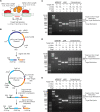Heterodimeric DNA methyltransferases as a platform for creating designer zinc finger methyltransferases for targeted DNA methylation in cells
- PMID: 20007601
- PMCID: PMC2836561
- DOI: 10.1093/nar/gkp1126
Heterodimeric DNA methyltransferases as a platform for creating designer zinc finger methyltransferases for targeted DNA methylation in cells
Abstract
The ability to target methylation to specific genomic sites would further the study of DNA methylation's biological role and potentially offer a tool for silencing gene expression and for treating diseases involving abnormal hypomethylation. The end-to-end fusion of DNA methyltransferases to zinc fingers has been shown to bias methylation to desired regions. However, the strategy is inherently limited because the methyltransferase domain remains active regardless of whether the zinc finger domain is bound at its cognate site and can methylate non-target sites. We demonstrate an alternative strategy in which fragments of a DNA methyltransferase, compromised in their ability to methylate DNA, are fused to two zinc fingers designed to bind 9 bp sites flanking a methylation target site. Using the naturally heterodimeric DNA methyltransferase M.EcoHK31I, which methylates the inner cytosine of 5'-YGGCCR-3', we demonstrate that this strategy can yield a methyltransferase capable of significant levels of methylation at the target site with undetectable levels of methylation at non-target sites in Escherichia coli. However, some non-target methylation could be detected at higher expression levels of the zinc finger methyltransferase indicating that further improvements will be necessary to attain the desired exclusive target specificity.
Figures




References
-
- Suzuki MM, Bird A. DNA methylation landscapes: provocative insights from epigenomics. Nat. Rev. Genet. 2008;9:465–476. - PubMed
-
- Deng G, Chen A, Pong E, Kim YS. Methylation in hMLH1 promoter interferes with its binding to transcription factor CBF and inhibits gene expression. Oncogene. 2001;20:7120–7127. - PubMed
-
- Smith AE, Hurd PJ, Bannister AJ, Kouzarides T, Ford KG. Heritable gene repression through the action of a directed DNA methyltransferase at a chromosomal locus. J. Biol. Chem. 2008;283:9878–9885. - PubMed
Publication types
MeSH terms
Substances
Grants and funding
LinkOut - more resources
Full Text Sources
Other Literature Sources
Molecular Biology Databases

